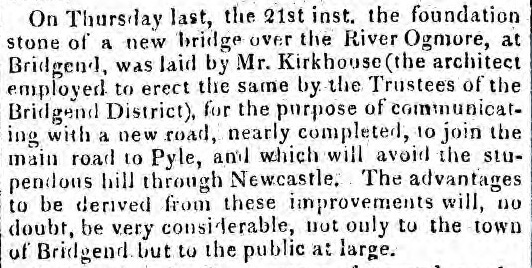Three Bridges of Bridgend.
By the start of the 1400s, the ford that was once the only crossing that connected the two hamlets of Nolton and Newcastle had become inadequate. Sometime during the next twenty-five years, the Old Stone Bridge was constructed.
The Old Stone Bridge was erected around c.1425 – It was originally a four-arched bridge, constructed of Quarella stone with cutwaters on both the upstream and downstream sides.
This was the structure that would give our town the name of Bridgend.
At the time of the construction, the Lordship of Glamorgan was held by Richard de Beauchamp, 13th Earl of Warwick and Isabel le Despenser. It is not known exactly who commissioned the building of the bridge but as both hamlets of Nolton and Newcastle were under the Lordship of the Gamage family (the Lord of Coity – main seat being Coity Castle) it may well have been them who did so.
Even though the bridge was erected c.1425, we see the earliest reference to Bridgend in a Nottage Court Muniments document dated the 11th of December, 1444. In this document, the town is referred to as "Bryggen Eynde".
On Monday the 21st of August 1775, Glamorgan was hit with a very heavy downpour of rain. At about nine o'clock in the evening, the town of Bridgend was laid underwater by the flooding of the River Ogmore. This flood led to inhabitants having to retreat to the upper rooms and roofs of their properties, walls were washed away and two arches of the Old Stone Bridge were swept away with it.
The two demolished arches were replaced by a single arch which gave the bridge its “lopsided” look. It is more than likely that the replacement arch was paid for by either county funds or by Turnpike Trustees.
By the 1820s, the Old Stone Bridge became inadequate. The steep ascent on both sides of the structure made the bridge inconvenient for travellers making their way to the developing Market Town. Although this was so, the last recorded use of it by a motor vehicle was in 1920.
In June of 1821, a new bridge was to be constructed. This new bridge would help people avoid the “stupendous Newcastle Hill” and would lead to the new road of Park Street which was built for that very purpose.
On the 21st of June, 1821 the foundation stone for the new bridge (subsequently called 'Newbridge') was laid by Mr W. Kirkhouse of Neath. Mr Kirkhouse was one of the architects employed by the Turnpike Trustees to design the bridge. Newbridge was a structure of three arches of stone.
With the development of cars, Bridgend saw an increase in traffic in the town. This made 'Newbridge' inadequate and in 1912 it was demolished. A reinforced concrete bridge was erected on the same site as its predecessor. Funded by Glamorgan County Council, it was officially opened on the 12th of July, 1912.








